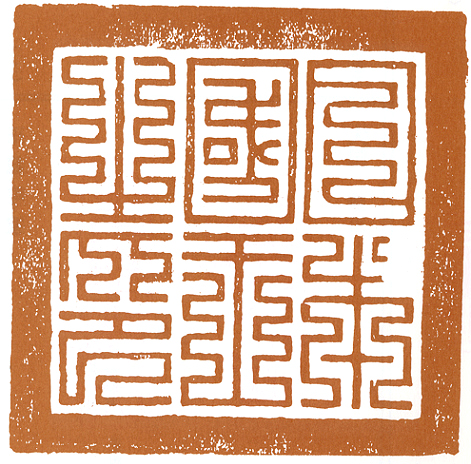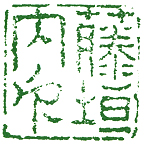Japanese ex-libris ownership stamps show an abundance of variations in substance, shape and color when compared with those of China and Korea. Here we would like to introduce a few of the more unusual ones.
Large Stamps and Small Stamps
The largest ex-libris ownership stamps are the "日新館図書記" of the Ominokuni Nishoji (later renamed "Nishioji") Clan School's "Nisshinkan" and the "嶰谷蔵書記" of Fukui Yoshimaro, which are both more than 15 cm long and 9 cm wide. In contrast, the smallest one was an oval stamp used by Nakamura Shunjo "中村" which was 6 mm long and 4 mm wide. The longest text on a stamp was on the one belonging to Fukui Yoshimaro mentioned above which had 238 characters.

Nisshinkan

Fukui Yoshimaro

Nakamura Shunjo
Old Stamps
The ex-libris ownership stamp coming from the most distant past are the "松宮内印" from the time of the Shomu Emperor (701 to 756), and the "積善藤家" and "内家私印" from the time of Empress Komyo (701 to 760).

Empress Komyo

Empress Komyo

Emperor Shomu
Unusual Ex-libris Ownership Stamps
Some stamps used Jindai characters (the ancient characters that are said to have been used in Japan before Chinese characters were introduced) that are considered very unusual, such as the text on the stamp of Kamo no Mabuchi and the "サカキノヤノシルシ" (sakakino yano shirushi) of Tokoyo Nagatane which is unclear in meaning. There is also Imao Kiyoka's stamp that uses the old Japanese syllabary (manyogana) to give us "奈泥志古曾能爾乎左牟留布美良乃思流之" (nadeshikozono ni osamuru fumira no shirushi) and Yamakawa Masanobu's "麻佐乃布" among others.

Imao Kiyoka

Tokoyo Nagatane

Kamono Mabuchi

Yamakawa Masanobu
Stamps with Animal and Plant Motifs
There are also ex-libris ownership stamps that do not use Japanese characters. For instance, Awashima Kangetsu's and Koizumi Yakumo's figure of a crow, Kato Eibian's figure of a turtle, Tachibana Moribe's figure of a Foo dog, Hanawa Hokiichi's and Kimura Senshu's figure of a mandarin orange tree, Niijima Yaeko's figure of a chrysanthemum, and Urushiyama Tendo's figure of a bird and a fish.

Urushiyama Tendo

Kato Eibian

Awashima Kangetsu

Koizumi Yakumo

Kimura Senshu

Niijima Yaeko

Tachibana Moribe
Imperial and Foreign Stamps
The stamp "松宮内印" of the Emperor Shomu mentioned above, and Emperor Komei's "此華" , Empress Gosakuramachi's "明和" are some of these stamps. Ex-libris ownership stamps used by foreigners, such as Ernest Satow "英国薩道蔵書" , Basil Hall Chamberlain "英王堂蔵書" and Frank Hawley "寶玲文庫" are some of the more well known examples. The stamp held by Oouchi Yoshitaka, a feudal lord during the period of Japan's civil wars, "日本国王之印" is a good example of the background during this period.

Emperor Komei

Ernest Satow

Emperor Shomu

Basil Hall Chamberlain

Empress Gosakuramachi

Frank Hawley

Oouchi Yoshitaka
Color Stamps
While the color of ex-libris ownership stamps most often used was vermilion, we can occasionally see black. Other than these two colors we have Matsudaira Tadafusa's "尚舎源忠房" and Wakizaka Yasumoto's "藤亨" which are indigo. Green is used for Motoori Oohira's "藤垣内印" and Konakamura Kiyonori's "阿豆麻居蔵". And Saeki Yukoku's "富山佐伯有穀蔵書" and Morita Shien's "森田" used brown. Honma Mitsuoka's "本間氏図書" gives us a unique example of an ex-libris ownership stamp using two colors.

Morita Shien

Motoori Oohira

Honma Mitsuoka

Konakamura Kiyonori

Saeki Yukoku

Matsudaira Tadafusa

Wakizaka Yasumoto
Column
- Variations in Ex-libris Ownership Stamps
- Why Vermilion Ink for Ex-libris Ownership Stamps?

